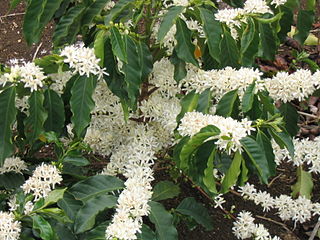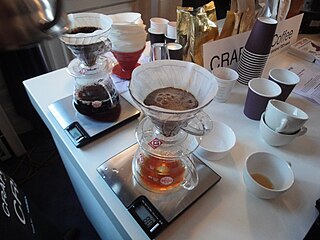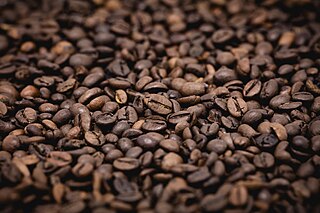Single-origin coffee is coffee grown within a single known geographic origin.
Single-origins can offer unique characteristics and specific tastes compared to blended coffees from multiple origins. [1] Coffee shops can market single-origin coffees specifically to add symbolic value to the coffee by highlighting the producer or the coffee's unique origin. [2] Consumers of specialty coffee are often attracted to single-origin coffee for the transparency it often attempts to convey. [3]
There are no universal rules, or governing bodies enforcing the labeling of coffee. However, there are governmental bodies in some countries that regulate the coffee market, for example in Brazil. [4]
While it is still difficult to accurately authenticate a coffee's origin, recent genomic research indicates that it is possible to identify a DNA fingerprint of coffee trees. [5] This technique may eventually allow buyers of un-roasted, green coffee, to authenticate a single-origin coffee. This would improve the transparency and traceability of coffee.
Single-origin coffees may come from a single farm, multiple farms from the same country, or just a blend of the coffees grown from that country. [6] [7] It could also mean an entire country which produces a comprehensive variety of beans, such as Brazil, Colombia, and Vietnam. [8]
Estate coffees are a specific type of single-origin coffee. They are generally grown on one massive farm, ranging in size from a few acres to large plantations occupying many square miles or a collection of farms that all process their coffee at the same mill. [9] Many countries in South and Central America have estate coffee farms, countries such as Colombia, Brazil, Costa Rica, and Mexico, have many estate farms. Starbucks owns a large majority of coffee farms in the Philippines, combining many small farms to form one giant cooperative farm.
Micro-lot or small-lot coffees are another type of specific single-origin coffee from a single field on a farm, a small range of altitude, and a particular day of harvest. [10] Many micro-lots are used for growing specialty coffee, which is some of the highest quality coffee offered on the market, which can range in prices.

Coffea is a genus of flowering plants in the family Rubiaceae. Coffea species are shrubs or small trees native to tropical and southern Africa and tropical Asia. The seeds of some species, called coffee beans, are used to flavor various beverages and products. The fruits, like the seeds, contain a large amount of caffeine, and have a distinct sweet taste.

Coffee is a beverage brewed from roasted, ground coffee beans. Darkly colored, bitter, and slightly acidic, coffee has a stimulating effect on humans, primarily due to its caffeine content. It has the highest sales in the world market for hot drinks. Decaffeinated coffee is also commercially available.

Coffee production is the industrial process of converting the raw fruit of the coffee plant into the finished coffee. The coffee cherry has the fruit or pulp removed leaving the seed or bean which is then dried. While all green coffee is processed, the method that is used varies and can have a significant effect on the flavor of roasted and brewed coffee. Coffee production is a major source of income for 12.5 million households, most in developing countries.

Home roasting is the process of roasting coffee from green coffee beans on a small scale for personal consumption. Home roasting of coffee has been practiced for centuries, using simple methods such as roasting in cast-iron skillets over a wood fire and hand-turning small steel drums on a kitchen stovetop.

Roasting coffee transforms the chemical and physical properties of green coffee beans into roasted coffee products. The roasting process is what produces the characteristic flavor of coffee by causing the green coffee beans to change in taste. Unroasted beans contain similar if not higher levels of acids, protein, sugars, and caffeine as those that have been roasted, but lack the taste of roasted coffee beans due to the Maillard and other chemical reactions that occur during roasting.

Coffee preparation is the making of liquid coffee using coffee beans. While the particular steps vary with the type of coffee and with the raw materials, the process includes four basic steps: raw coffee beans must be roasted, the roasted coffee beans must then be ground, and the ground coffee must then be mixed with hot or cold water for a specific time (brewed), the liquid coffee extraction must be separated from the used grounds, and finally, if desired, the extracted coffee is combined with other elements of the desired beverage, such as sweeteners, dairy products, dairy alternatives, or toppings.

The history of coffee dates back centuries, first from its origin in Ethiopia and later in Yemen. It was already known in Mecca in the 15th century. Also, in the 15th century, Sufi monasteries in Yemen employed coffee as an aid to concentration during prayers. Coffee later spread to the Levant in the early 16th century; it caused some controversy on whether it was halal in Ottoman and Mamluk society. Coffee arrived in Italy in the second half of the 16th century through commercial Mediterranean trade routes, while Central and Eastern Europeans learned of coffee from the Ottomans. By the mid 17th century, it had reached India and the East Indies.

Coffee is a popular beverage and an important commodity. Tens of millions of small producers in developing countries make their living growing coffee. Over 2.25 billion cups of coffee are consumed in the world daily. Over 90 percent of coffee production takes place in developing countries — mainly South America — while consumption happens primarily in industrialized economies. There are 25 million small producers who rely on coffee for a living worldwide. In Brazil, where almost a third of the world's coffee is produced, over five million people are employed in the cultivation and harvesting of over three billion coffee plants; it is a more labor-intensive culture than alternative cultures of the same regions, such as sugar cane or cattle, as its cultivation is not automated, requiring frequent human attention.
Moloka‘i coffee refers to a legally protected, geographical indication of coffee grown on the island of Molokai in Maui County, Hawai‘i, and processed to specific, legally defined standards. Similar to Kona coffee, Molokai coffee is a market name for a product of specific origin and of a defined quality. Requirements for Moloka‘i coffee not only dictate the origin and quality, but also label design and placement on product package.
Specialty coffee is a term for the highest grade of coffee available, typically relating to the entire supply chain, using single-origin or single-estate coffee. The term was first used in 1974 by Erna Knutsen in an issue of Tea & Coffee Trade Journal. Knutsen used specialty coffee to describe beans of the best flavor which are produced in special micro-climates.

Coffee production has been a major source of income for Vietnam since the early 20th century. First introduced by the French in 1857, the Vietnamese coffee industry developed through the plantation system, becoming a major economic force in the country. After an interruption during and immediately following the Vietnam War, production rose once again after Đổi mới economic reforms, making coffee second only to rice in value of agricultural products exported from Vietnam.

Gesha coffee, sometimes referred to as Geisha coffee, is a variety of coffee tree that originated in the Gori Gesha forest, Ethiopia, though it is now grown in several other nations in Africa, Asia, and the Americas. It is widely known for its unique flavor profile of floral and sweet notes, its high selling price, and its exclusivity as its demand has increased over the years.
Third-wave coffee is a movement in coffee marketing emphasizing high quality. Beans are typically sourced from individual farms and are roasted more lightly to bring out their distinctive flavors. Though the term was coined in 1999, the approach originated in the 1970s, with roasters such as the Coffee Connection.
Direct trade is a form of sourcing practiced by certain coffee roasters, chocolate makers, tea sellers, gemologists and more who build direct relationships with the farmers, artisanal miners and processors who sell their products. There is no single set of direct trade standards, and specific trade practices vary as a reflection of business and ethical priorities of the roaster or maker. Generally speaking, however, direct trade practitioners view their model as one of mutually-beneficial and transparent trade relationships.

iperEspresso is a single-serve capsule system for preparing espresso coffee and espresso-based drinks, developed and patented by Illy.

Peru is one of the top 20 coffee producers in the world as of 2014. It ranks fifth in the export of Arabica in the world market.

Thailand is one of the top 25 coffee producers in the world as of 2014, but its status as a coffee origin has not been widely known. Thailand traditionally produced mainly Robusta for industrial use, but the country has quickly become an exciting emerging origin for specialty Arabica and fine Robusta coffees. The origin is unique in that it exports very little coffee and most of the consumption remains in the country. There is a booming specialty coffee ecosystem where farmers, roasters, cafes and consumers symbiotically co-exist. It is often seen as an example of a working coffee ecosystem for an origin where coffee produced is sustainable from both economic and environmental perspectives.
Countries have cultivated coffee beans into various vehicles to satisfy needs unique to each country. Whether it be for energy, socialization, or tradition, the cultivation of coffee has served as a motivating force of the world. The modernization of coffee and its unique forms across cultures are markers of tradition and modern changes across continents. Coffee culture appears in the way in which people consume coffee, the way they make it, and where coffee is served and shared. Each of these factors combined reflects the lives of the people in these countries and the importance of coffee across the world.

Coffee culture has become a significant cultural phenomenon in Australia.